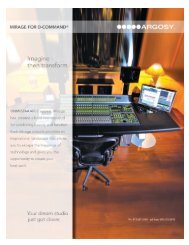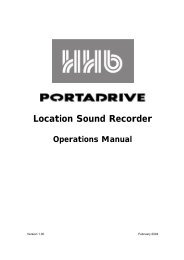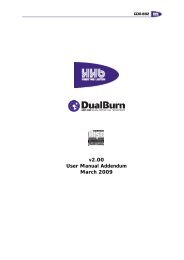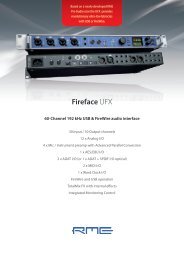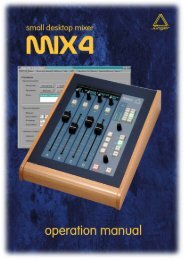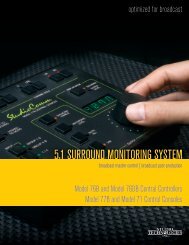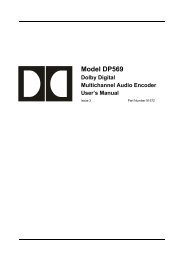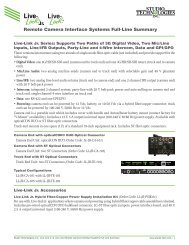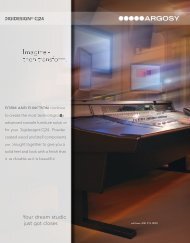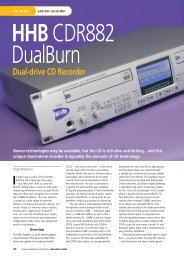Owner's Manual - Antares
Owner's Manual - Antares
Owner's Manual - Antares
Create successful ePaper yourself
Turn your PDF publications into a flip-book with our unique Google optimized e-Paper software.
9<br />
NOTE: It is important to keep in mind<br />
that the purpose of this setting is to<br />
“undo” the effect of any low-cut filter<br />
that was used to capture your audio. If you play<br />
around with this setting, you may initially think<br />
that it’s working “backwards.” That is, changing<br />
the menu selection from OFF to any filter<br />
setting will actually cause a bass boost in the<br />
monitored audio.<br />
However, once you think about it, you will<br />
realize that this is the way it’s supposed to<br />
work. The purpose of all the controls in the<br />
Source Mic section is to neutralize the effects of<br />
the source mic. So, when you select a low-cut<br />
filter, you’re telling the Mic Mod EFX that the<br />
source mic recorded the audio with that much<br />
bass attenuation and, therefore, the model<br />
must now boost the bass an equal amount to<br />
remove the source mic’s sonic coloration. (Trust<br />
us, this fried our brains a bit at first, too.)<br />
Pattern<br />
If the mic you select in the Source Mic menu is<br />
equipped with user-selectable pick-up patterns<br />
(i.e., omni, cardioid, hypercardioid, etc.), the<br />
Pattern pop-up menu will allow you to select<br />
from the actual pattern settings available on that<br />
mic. (If the source mic does not have selectable<br />
patterns, the menu will be grayed out.)<br />
If the source mic does include multiple<br />
patterns, select the pattern that was (or will be)<br />
used when capturing your audio.<br />
NOTE: The purpose of the Pattern<br />
selection is to neutralize the varying<br />
frequency characteristics that result<br />
from each of the available pattern settings, with<br />
the assumption that the audio was recorded<br />
on axis (i.e., from the front of the microphone).<br />
Since Mic Mod EFX has no way of knowing the<br />
actual placement of the signal source, it does<br />
not attempt to simulate off-axis performance.<br />
Proximity<br />
The Proximity knob in the Source Mic section<br />
should be used to set the average distance that<br />
separated the mic and the signal source during<br />
the recording of the audio. The purpose of this<br />
control is to allow the model to remove any<br />
Proximity Effect that may have been introduced<br />
by the source mic.<br />
NOTE: Proximity Effect is a boost<br />
in bass frequencies resulting from<br />
placing a directional mic in close<br />
proximity to a signal source. The amount of the<br />
effect varies from mic to mic, and is inversely<br />
proportional to the distance from the mic to the<br />
source (i.e., the smaller the distance, the greater<br />
the bass boost).<br />
Mics operating in omnidirectional mode do not<br />
exhibit a proximity effect. Consequently, if the<br />
source mic is an omni mic, or the source mic<br />
has selectable patterns and omni is chosen, the<br />
Proximity control will be disabled.<br />
NOTE: Like the Low-Cut control<br />
described above, the Source Mic<br />
Proximity control may initially<br />
seem to be working backwards (i.e., setting a<br />
shorter distance will result in an audible bass<br />
attenuation). Refer to the explanation back up in<br />
the Low-Cut section to understand why this is<br />
actually how it is supposed to work.<br />
Also note that the effect of the Proximity<br />
control is unique for each model of microphone.<br />
Mic Mod EFX does not use a generalized<br />
approximation of proximity effect. Each model<br />
reflects the specific physical properties that<br />
create the proximity effect for that individual<br />
mic.



